Distinguishing yourself from the overwhelming amount of information available on search engines is crucial for success. Enter rich snippets – an advanced approach to improving your website’s visibility and engagement on search engine results pages (SERPs). This powerful tool can significantly boost your SEO efforts while enhancing user experience. Read on to discover the ins and outs of rich snippets, including their benefits, various types, best practices for implementation, and how they can help you take your digital presence to new heights.
What Are Rich Snippets in SEO?
Rich snippets are enhanced versions of regular search results which offer additional context and data about a webpage’s content. They do this by utilizing structured data markup. This behind-the-scenes code helps search engines better understand and interpret the content on your web pages.
What is snippet vs rich snippet?
A snippet is a concise summary of a webpage’s content displayed below its title on SERPs. It typically includes the page URL and a brief description or a relevant excerpt pulled from the site’s metadata.
On the other hand, rich snippets enhance these standard summaries by providing extra layers of information such as images, ratings, prices, or even video previews. This creates more visually interesting search results that demand attention from users while giving them valuable insights—often making them more likely to click through to your website.
Rich Snippets vs. Rich Results vs. Search Engines Results Page Features
You may come across similar terms like rich results and SERP features when diving into advanced SEO techniques like rich snippets. It’s essential to clarify these concepts:
- Rich snippets: As already explained, these are expanded versions of traditional text-based search result listings.
- Rich Results: These encompass all enhancements made possible by adding structured data markup—not just rich snippets but also carousels, image packs, and more.
- SERP Features: A broader category that includes all types of search result enhancements creating a more engaging experience on results pages, such as rich snippets, knowledge panels, local business listings, ads, featured snippets, and much more.
By deploying these advanced SEO strategies like rich snippets and understanding their context within the larger framework of SERP features and rich results, you can create user-friendly web content that stands out in search engine listings—helping to drive traffic back to your site.
Benefits of Rich Snippets
Rich snippets provide numerous benefits to website owners and users by enhancing the presentation of search results. By implementing rich snippets into your SEO strategy, you can enjoy advantages such as improved click-through rates, increased visibility in search engines, and a more user-friendly experience.
Higher Click-Through Rates (CTR)
One significant benefit of using rich snippets is the potential increase in click-through rates (CTR). With rich snippets offering additional information directly within the search results, potential visitors are more likely to click on your website if they find the details helpful or relevant. This contextual information helps users decide which search result to choose, ultimately driving more traffic to your site.
Increased Visibility in Search Results
Rich snippets naturally draw attention with visually appealing elements like images, star ratings, and product data displayed prominently in search results. These eye-catching features help your content stand out among competitors, making it easier for users to notice and engage with your page. As a result, websites utilizing rich snippet markup tend to receive higher rankings on SERPs (Search Engine Results Pages) than those without.
Improved User Experience
Users searching for specific information or products appreciate having that additional data available at a glance through rich snippets. This streamlining improves the overall user experience by saving time spent clicking through various pages while searching for desired content. Enhancing customer satisfaction could also lead to better brand recognition and consumer trustworthiness.
Better Content Targeting
Implementing rich snippet markups on your site allows Google’s algorithms to grasp better what each webpage is about – an article review or product offer. Rich snippets help target the right audience by showing them relevant details in SERPs before clicking the link. This specificity makes visitors more likely to land on a page tailored precisely to their needs. It reduces bounce rates caused by irrelevant content being served up accidentally.
In conclusion – whether you want to improve your website’s click-through rates, boost search engine visibility, or create a better user experience – rich snippets can play an invaluable role in achieving these objectives. Integrating them into your SEO strategy will help you gain a competitive advantage and attract a targeted audience more efficiently.
Types of Google Rich Snippets [with Examples]
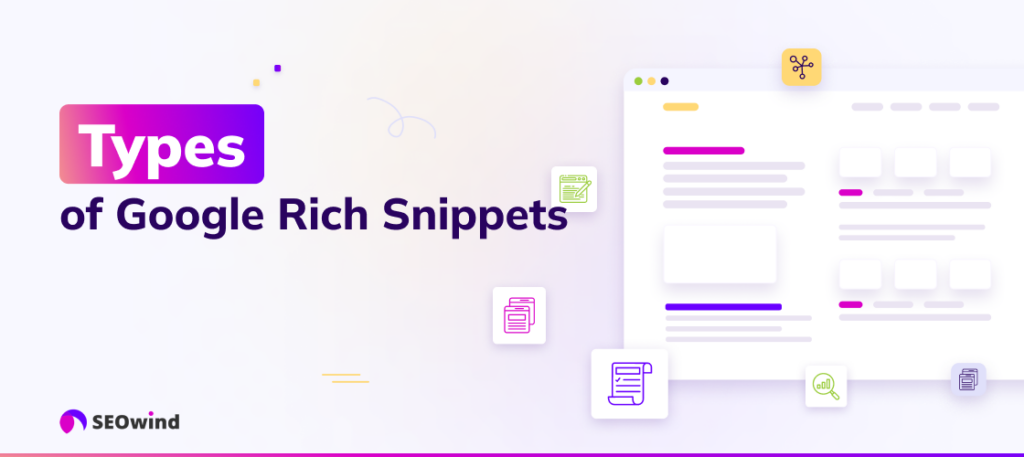

Exploring the various types and examples is essential to understand better how rich snippets work in SEO. Each type represents a unique category with specific attributes that help search engines and users quickly identify the content on a webpage.
Organization Rich Snippet & Schema Markup
The organization schema markup provides information about a company or organization. This includes names, logos, addresses, contact information, and social media profiles. The main benefit of using this rich snippet type is improved brand visibility and trustworthiness on search engine results pages (SERPs).
Organization Rich Snippet Example
Google displays a knowledge panel for an organization featuring its logo, address, phone number, and social media platforms when the appropriate schema markup is implemented on the website.
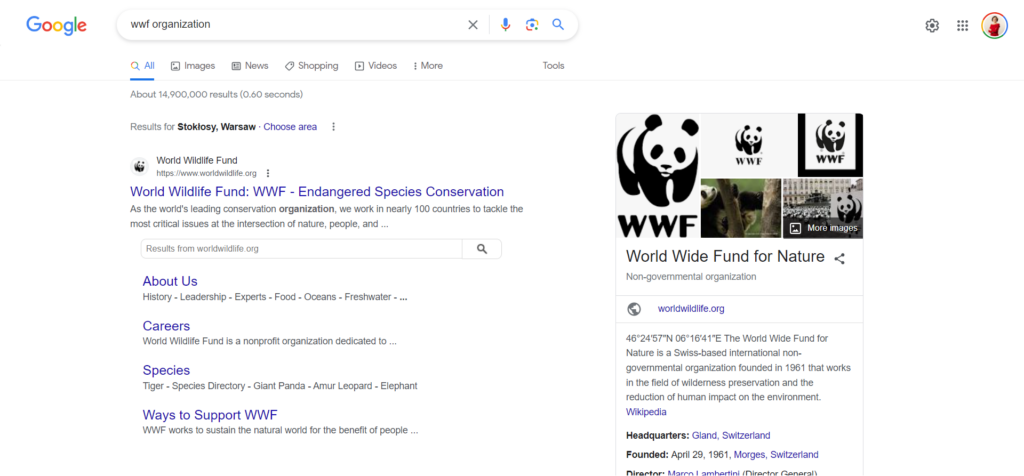

Person Rich Snippet & Schema Markup
Person schema markup helps showcase detailed information about individuals. This can be used for professionals like authors, speakers, doctors, or other field experts. Adding person schema markup to your website’s pages containing personal data (name, job title, professional achievements) makes it easier for search engines to index this critical information accurately.
Person Rich Snippet Example
An author might display their name under an article or book title alongside other relevant details like their occupation and social media profiles.


Local Business Rich Snippet & Schema Markup
Local business schema markup allows small and local businesses to display crucial information directly within SERPs. This can include business names, addresses, phone numbers, hours of operation, photos/videos of the establishment, or products/services offered.
Implementing local business schema markup correctly on your site’s page(s) about your enterprise ensures nearby customers can find you more accessible through search engines while improving your online presence overall.
Local Business Rich Snippet Example
A restaurant listing may show up with its contact details, such as opening hours and telephone number, along with customer review ratings.
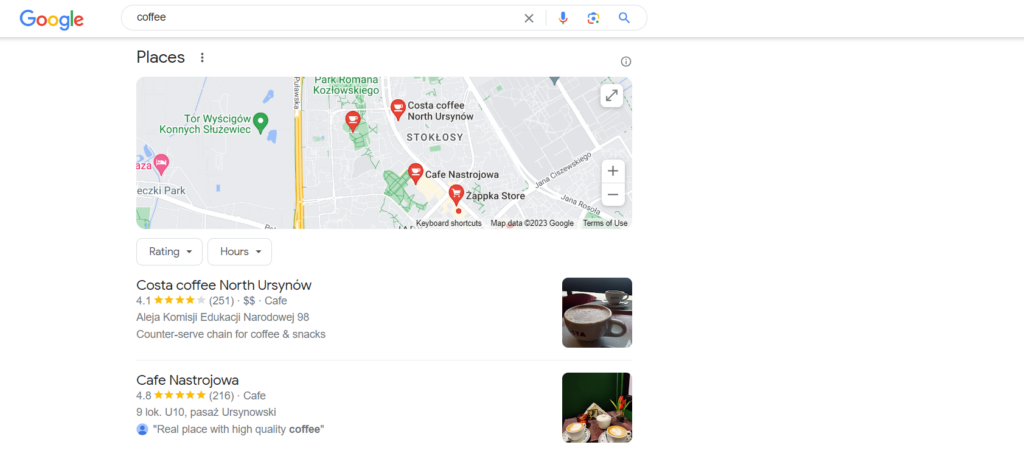

Product & Offer Rich Snippet & Schema Markup
Product and offer schema markups aim at providing detailed product information such as descriptions, prices, availability, and other critical attributes. Adding these markups to your eCommerce site or product pages enhances the user experience of online shoppers navigating the SERPs.
Product Rich Snippet Example
An electronics store displays TVs with their prices, specifications, and aggregated customer review ratings.
Article Rich Snippet & Schema Markup
The article schema markup is tailored for content-based websites like news articles and blog posts. It can help distinguish between regularly published material (e.g., daily news) and long-form content that might be considered “evergreen” in nature. Through this rich snippet type, search engines better understand the contents of each article, leading to improved search result ranking for related queries.
Article Rich Snippet Example
When searching for breaking stories, a popular news website displays headlines in a carousel format on Google’s main results page.
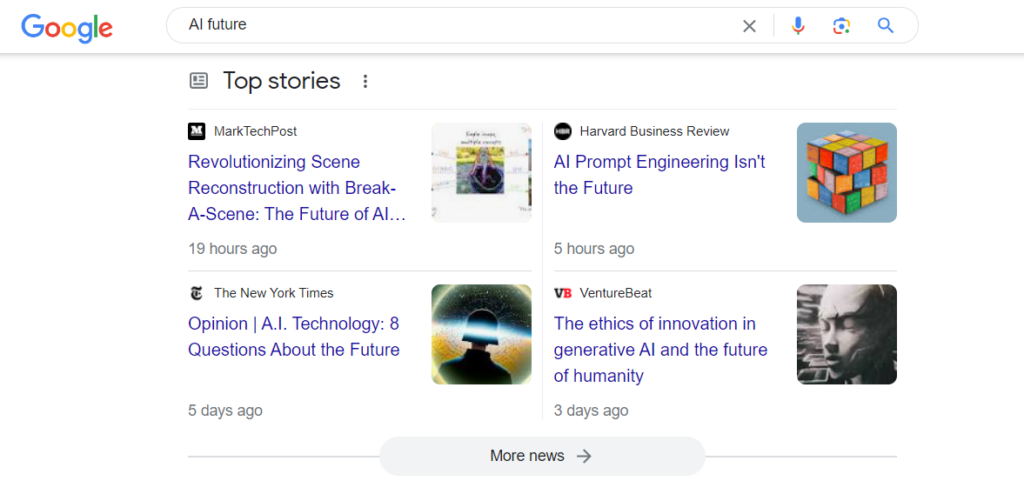

Video Rich Snippet & Schema Markup
Video schema markup aids in presenting relevant video data on SERPs by including essential information such as description, duration, thumbnail images, and view count. This greatly benefits users who prefer video content over written text while seeking new sources online through search queries.
Video Rich Snippet Example
When searching for instructional videos about cooking techniques on Google, multiple options appear with an accompanying thumbnail image and the total number of views garnered.
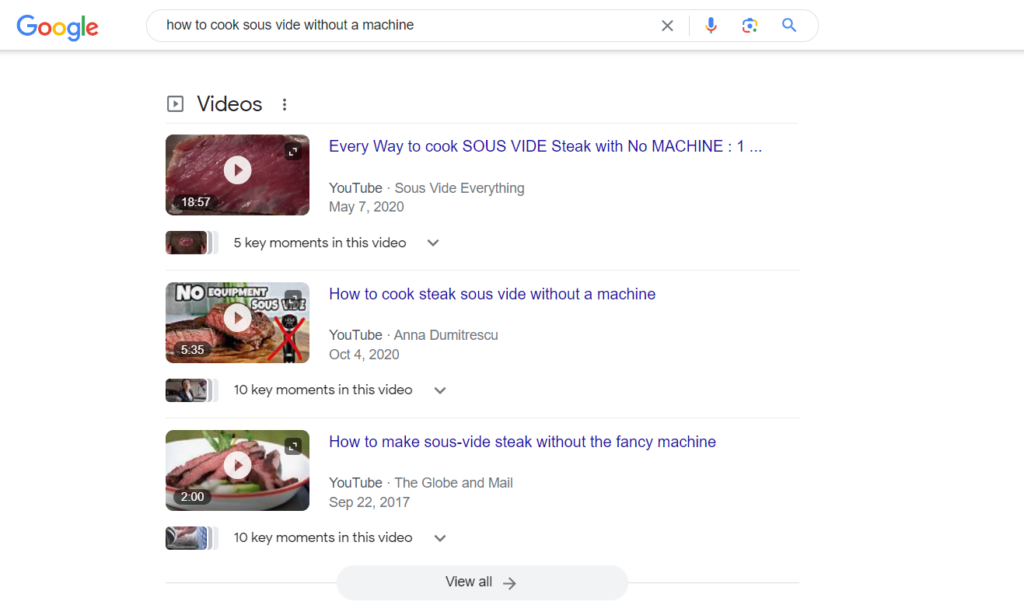

Event Rich Snippet & Schema Markup
Event schema markup enhances the visibility and understanding of various events happening online or offline by incorporating valuable details such as event name, location, date, time, and ticket pricing within the search results. This dramatically improves the user experience for those seeking event-related information and increases the chances of attracting more attendees.
Event Rich Snippet Example
When searching for a live music concert in a certain city on a specific date, numerous options appear on Google with relevant details like event title, venue, date, and ticket pricing, all at a glance. This allows users to easily compare and make decisions about attending the events that best suit their interests and schedules.
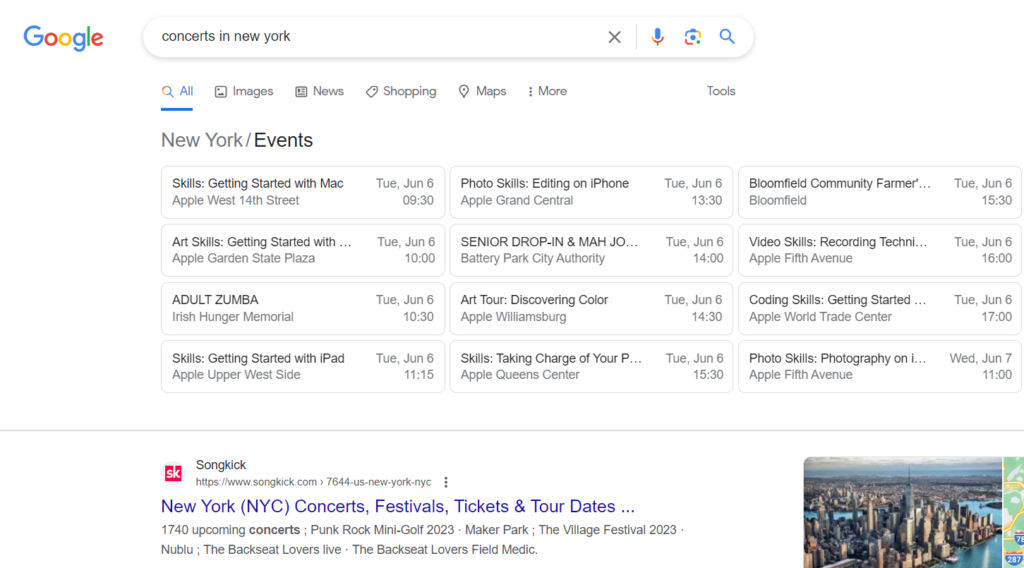

Recipe Rich Snippet & Schema Markup
Recipe schema markup enhances the display of rich snippets on search engine results pages by providing valuable insights about a particular recipe. It presents essential information such as the required ingredients, cooking time, nutritional information, and even user ratings, all in a visually appealing format.
Recipe Rich Snippet Example
When searching for a chocolate cake recipe, Google can display rich snippet information such as an image, preparation and cooking time, a list of ingredients, and average user ratings from a popular cooking website. This allows users to quickly evaluate which recipe suits their taste and skill level before clicking to learn more.
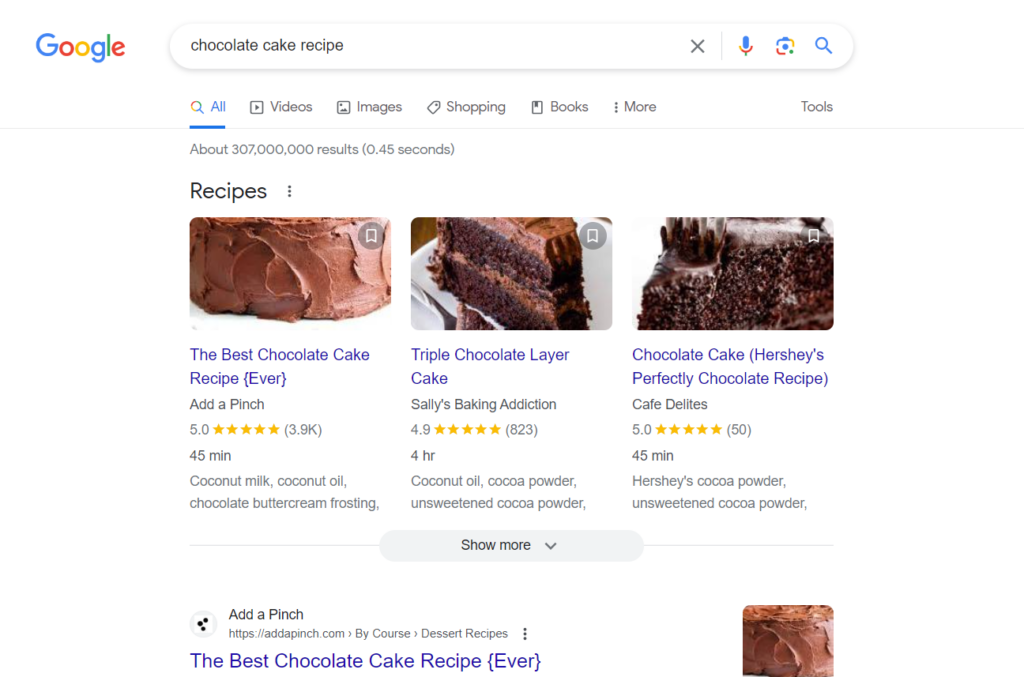

Rating/Review Rich Snippet & Schema Markup
Rating and review schema markup play a crucial role in displaying rich snippets for businesses and individuals on search results pages. It showcases their product or service ratings and customer feedback directly within the rich snippet, enhancing the overall user experience. This allows potential clients to assess the quality and popularity of a product or service based on aggregated public opinion.
Rating Rich Snippet Example
When looking for a local Italian restaurant on Google, search results may display rich snippets including the average star rating and a summary of customer reviews for each establishment. This helps users identify well-reputed eateries for their meal or event plans quickly, improving their decision-making process.
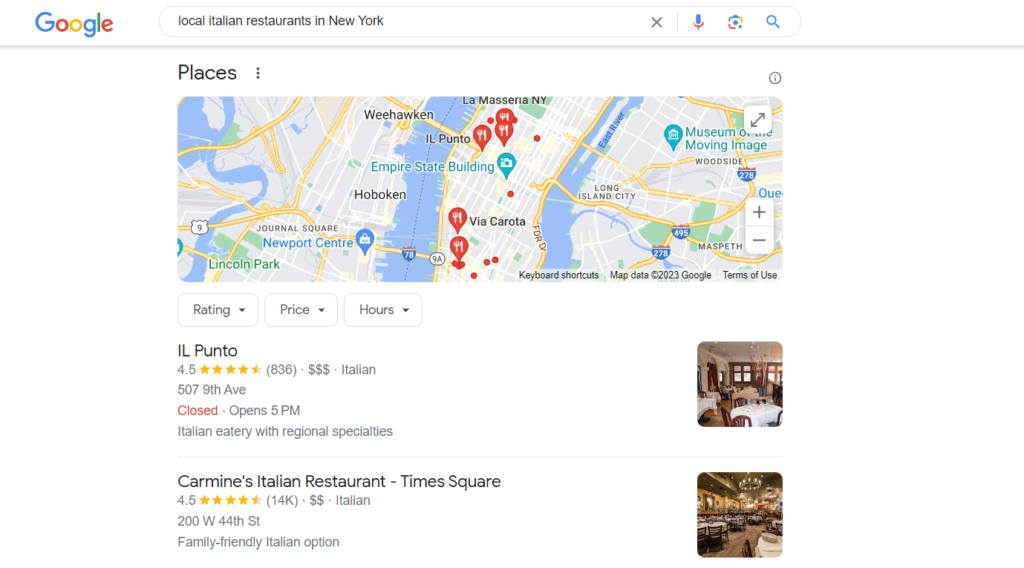

FAQ Rich Snippet and Schema Markup Code
FAQ Rich Snippets, powered by FAQ schema markup, enhance the search experience by showcasing a list of frequently asked questions directly on the search engine results page (SERP) for relevant queries. Users can get rich snippet results to access quick, informative answers, which not only increases their satisfaction but also boosts the website’s organic traffic.
FAQ Rich Snippet Example
When searching for “how to choose the right mattress” on Google, an online mattress retailer’s website with FAQ schema markup implemented can achieve a prominent position in the search results by using code snippet techniques. This displays questions like “How do I know what type of mattress is best for me?” or “Is it better to sleep on a hard or soft mattress?”, along with their respective answers. This allows users to effectively receive the information they seek without having to navigate to multiple websites.
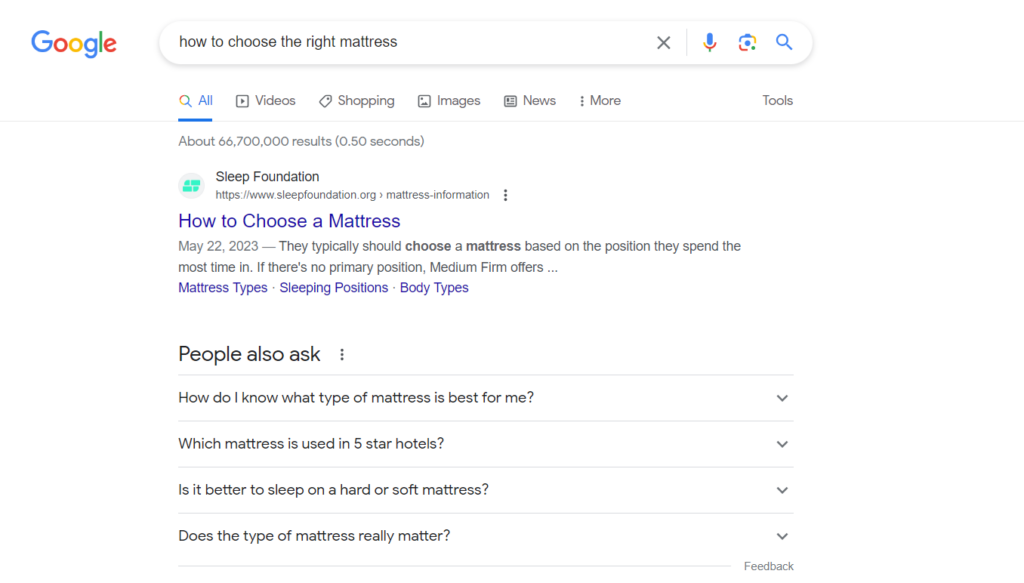

Types of Schema Encoding
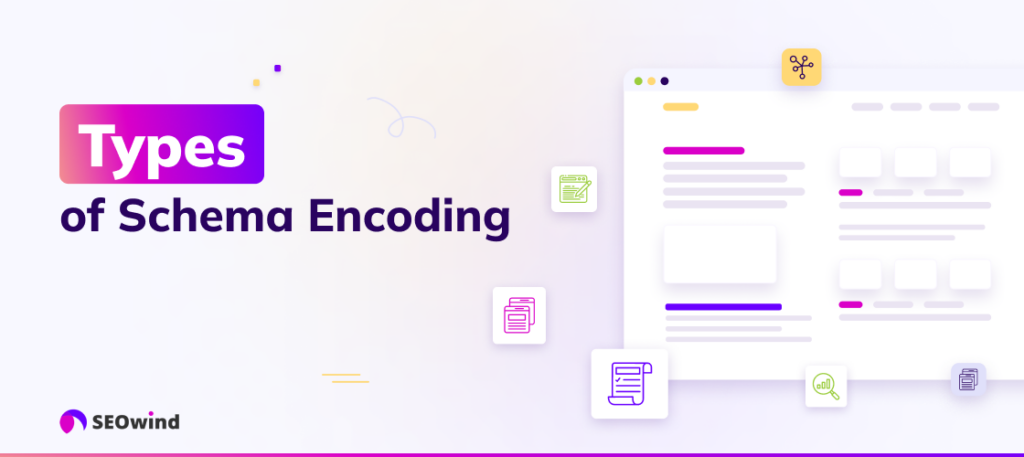

When implementing rich snippets on your website, one crucial aspect is choosing the correct schema encoding method. Rich snippets rely on structured data in a specifically coded format that search engines can understand. In this section, we will discuss three primary types of schema encoding methods used in SEO:
JSON-LD (JavaScript Object Notation for Linked Data)
JSON-LD is the most recommended and popular schema encoding method among web developers and SEO experts because it offers numerous advantages:
- Easy to implement: JSON-LD separates the markup from the HTML content, making it easier for developers to create and maintain.
- High readability: The syntax is more straightforward than other encoding methods.
Search engines like Google have also preferred JSON-LD because of its efficiency when processing structured data markup.
Microdata
Microdata, another common encoding type, integrates directly into your website’s HTML coding. Some key characteristics of Microdata include:
- Direct embedding within the HTML content.
- Readability thanks partly due to custom attributes added to individual elements/tags.
Although both Google and Bing support Microdata, its main disadvantage lies in how intertwined it becomes with your HTML code – potentially being messier than JSON-LD and harder to maintain over time.
RDFa (Resource Description Framework in Attributes)
RDFa shares some similarities with Microdata by incorporating metadata directly into your site’s existing codebase using unique attributes. Key features include:
- Compatibility across multiple document formats like XML or SVG
- A higher degree of flexibility compared to Microdata when it comes to presenting complex data structures
Despite RDFa’s merits as an encoding method for rich snippets, it might be challenging for beginners due to its complexity. Additionally, some search engines may not support RDFa as broadly as they do with JSON-LD or Microdata.
Each encoding method has its unique use cases and advantages. However, JSON-LD is currently the most widely supported and preferred choice in SEO for implementing schema markup due to its simplicity and readability. As a content creator or website owner, it’s crucial to understand your project’s requirements before selecting the most suitable schema encoding type that enhances your SEO efforts effectively.
How to Create Rich Snippets on Your Website


To add rich snippets, you’ll need a solid understanding of structured data and the various types available. This section will guide you through the comprehensive process of selecting an appropriate type, creating and adding structured data markup to your pages, and validating your structured data before applying it to boost your website’s search engine visibility.
Understand Structured Data
Structured data is a standardized format search engines use to understand and categorize web content more effectively. It allows you to explicitly highlight essential information about your page directly within its HTML code using specific syntax. Ultimately, providing structured data helps search engines better comprehend your content’s context to display highly relevant rich results for users.
Some examples of syntaxes used for implementing structure data include:
- Microdata
- JSON-LD (JavaScript Object Notation – Linked Data)
- RDFa (Resource Description Framework in Attributes)
Google and other major search engines strongly recommend using JSON-LD as it simplifies embedding and doesn’t affect how visitors visually experience your website.
Choose an Appropriate Rich Snippet Type
Numerous rich snippet types are available, each designed to convey specific sets of information depending on the nature of your content. It’s crucial to choose the most relevant one for enhanced SEO efficiency. There are various types of rich snippets from organization and person to article, video and rating schema markups, and many more.
Create & Add Structured Data Markup to Your Pages
Once you’ve determined your page’s most suitable rich snippet type, it’s time to create and add the corresponding structured data markup.
Implementing rich snippets on your website can significantly increase visibility and click-through rates in search engine results pages (SERPs). To integrate these valuable SEO enhancements, you must use structured data markup, tools that cater specifically to WordPress users, and test the rich snippet implementation. In this section, we’ll explore each of these three aspects.
Structured Data Markup Helper
Google provides a free tool called Structured Data Markup Helper that assists with generating the appropriate markup for your content. By using this tool, you can add various types of rich snippets to your website seamlessly. Here’s how to utilize it:
- Visit Google’s Structured Data Markup Helper.
- Choose the type of content you’d like to create the markup for (article, event, product, etc.), then click “Start Tagging.”
- On the next screen, enter a page’s URL or HTML source code containing the content that needs markup.
- Highlight and tag relevant elements within your content (title, author name, image URL) based on the chosen content type.
- When completed, click “Create HTML” to generate the JSON-LD or microdata markup language adaptation suitable for your webpage.
- Add the generated script to your specific web page’s code and deploy it on your site for Google’s crawlers to process.
WordPress Plugins
For websites built on WordPress, various plugins are available for automating and simplifying adding rich snippets through structured data markup:
- Schema: A comprehensive solution that supports all schema.org markups, including organization schemas, person schemas, video schemas, local business schemas, etc., enabling different types of rich snippet integration.
- WP Review Pro: This plugin is ideal for websites with reviews and ratings. It supports multiple rating systems, including star ratings, and automatically generates a rich snippet schema.
- Recipe Maker: This plugin provides specific benefits for food bloggers or recipe-focused websites, simplifying the creation of recipe schema markup to enable your site’s recipes to display in SERPs.
These plugins offer an easier way of managing structured data while catering to specific niche requirements or content types.
Validate Your Structured Data
Test your newly implemented rich snippets using Google’s Rich Results Test before deploying them fully. This testing tool identifies issues with your structured data implementation and provides suggestions for rectifying these errors.
To use the Rich Results Test:
- Visit the website and enter the URL containing your structured data.
- Click “TEST URL” to initiate the analysis.
- Review any errors or recommendations indicated by Google’s tool and make required adjustments upon completion.
- Repeat this testing process until all issues are resolved, ensuring optimal displaying of rich snippets in search results.
By thoroughly understanding structured data types and syntaxes, choosing the right rich snippet types for individual pages, creating and incorporating customized markup code, and validating that implementation— you’ll be well on your way to supercharging your SEO with targeted rich snippets.
Best Practices for Implementing Rich Snippets


Implementing rich snippets to enhance your website’s SEO performance is a highly rewarding process when done correctly.
This section will explore some proven best practices you should consider while implementing rich snippets on your site.
Do Your Research and Choose the Appropriate Rich Snippet Type
Before implementing rich snippets, it’s essential to clearly understand the kind of rich snippet most suitable for your content. As mentioned earlier in the article, there are various types of schema markup, such as organization, product, events, or articles. Consider researching all available schemas and choose an appropriate type relevant to your business and industry.
Use Google’s Structured Data Testing Tool
To ensure that your structured data markup is implemented correctly and formatted according to Google’s guidelines, use Google’s Structured Data Testing Tool before launching the changes on your website. This tool helps you identify any errors in the markup so that they can be corrected before negatively affecting your search engine ranking.
Prioritize High-Quality Content
Although adding rich snippets can help boost your visibility in search results, you must pay attention to the importance of creating high-quality content for users. Remember that search engines prioritize user experience over technicalities like schema markup. Ensure that your webpage’s content adds value to both the reader and meets their needs before focusing solely on optimizing it for search engines.
Stay Up-to-Date With Schema Markup Guidelines
Google updates its algorithms regularly, directly impacting how websites are ranked in search results. Similarly, schema markup requirements also change periodically. To maintain high rankings in SERPs (Search Engine Results Pages) and get rich snippets:
- Routinely check Google’s official guides related to structured data.
- Remain active in online communities discussing the latest updates in SEO practices.
- Make necessary adjustments to your schema markup based on new guidelines.
Use Descriptive, Accurate, and Compelling Information
Lastly, ensuring the information provided in the rich snippets is relevant, accurate, and compelling will significantly attract users to click through to your site. Misleading or outdated information may only result in high bounce rates, which could negatively impact overall user experience and search rankings. Keep your site’s data up-to-date and carefully crafted for maximum user engagement.
By keeping these best practices in mind during the implementation process of rich snippets, you can be sure that you are taking vital steps toward supercharging your website’s SEO performance and providing an enhanced user experience for potential visitors.
Monitoring Rich Snippets Performance
Keeping an eye on the performance of your rich snippets is essential for maintaining a solid SEO strategy and enhancing your website’s visibility. To effectively monitor the success of rich snippets implementation on your site, you must know what tools to use and which key metrics to analyze.
Google Search Console
Google Search Console is the primary tool for monitoring how rich snippets perform in real-world search results. With this free utility from Google, you can:
- Quickly identify structured data errors or issues that may prevent rich snippet display.
- Access detailed reports highlighting the different types of schema markup implemented on your site, including rich snippet impressions and click-through rates (CTR).
- Keep track of changes over time, enabling you to tweak and optimize your approach for better results.
To efficiently use Google Search Console for monitoring rich snippets performance, follow these steps:
- Log into your Google Search Console account.
- Select the desired property and navigate to Search Appearance > Structured Data.
- Review any warning messages or errors on your site’s schema markup here.
- Click on Search Appearance > Rich Results to access insights about each type of structured data featured on your website.
Key Metrics to Analyze
There are specific metrics that help determine whether implementing various rich snippet types has had a positive impact on SEO goals:
- Impressions: An increase in impressions implies that more users view your pages with rich snippet content within search engine result pages (SERPs). Stronger impressions usually indicate that well-crafted structured data has enhanced visibility.
- Click-through Rate (CTR): A higher CTR demonstrates a more compelling SERP appearance due to valuable information provided by relevant-rich snippets making it easier for users to make informed decisions when clicking on a link.
- Average Position: This metric refers to how high up in SERPs a particular page ranks. Suppose the implementation of rich snippets drives a better average position. Your content is likely to succeed in capturing user attention within search results.
Conducting Regular Reviews
It’s crucial to consistently monitor and adjust the structured data markup on your site. This approach lets you immediately adjust any issues that Google detects with your schema, allowing continuous improvements over time.
Furthermore, monitoring performance helps identify trends and correlations that offer new growth opportunities. For example, improving ratings or gathering more reviews may result in a higher CTR and unimaginable return on investment (ROI).
Regularly tracking rich snippet performance through tools like Google Search Console and analyzing key metrics is essential in optimizing your SEO strategy’s success. Stay proactive in maintaining a competitive edge by ensuring your structured data efforts convert into efficient customer engagement and improved online visibility.
Rich Snippet Plugin Solutions for WordPress
Efficiently implementing rich snippets on your WordPress website can significantly improve its search engine visibility and click-through rates. Fortunately, various plugins make this process easier for beginners and seasoned professionals. In this section, I will highlight some popular rich snippet plugin solutions for WordPress that can help you enhance your site’s SEO with minimal effort.
All in One Schema Rich Snippets
As the name suggests, All in One Schema Rich Snippets is an all-encompassing solution designed to simplify the schema markup implementation on your site. The plugin supports various content types, such as articles, events, products, recipes, ratings/reviews, etc. It offers a user-friendly interface for adding structured data while also allowing Google and various other search engines to comprehend and present crucial information attractively adequately.
WP Review Pro
WP Review Pro is a WordPress plugin specifically designed to add review-based rich snippets to your blog or website. This powerful plugin offers 19 schema markup types: a versatile solution tailored to suit websites within diverse industries (from restaurant reviews to software comparisons). It generates interactive rating systems — stars, points, or percentages — enabling users to submit their evaluations while strengthening their credibility and authenticity within search results.
Rank Math
Another comprehensive plugin worth mentioning is Rank Math, hailed as the “Swiss Army Knife” of SEO plugins due to its extensive toolkit, which includes support for schema markup integration. With predefined templates available (such as those required for Local Business Schema Markup), guiding site optimization becomes more manageable than ever! Moreover, Rank Math’s compatibility with leading page builders like Gutenberg ensures seamless integration with virtually any website theme.
Schema & Structured Data for WP & AMP
For those who have implemented Accelerated Mobile Pages (AMP) on their WordPress sites, the Schema & Structured Data for WP & AMP plugin is designed to boost your SEO efforts.
This plugin supports over 35 schema types, automatically adding essential markup elements while accommodating custom requirements as needed. Additionally, its inbuilt review module easily handles ratings and testimonies – creating a visually enticing experience for potential visitors browsing via search engines.
When selecting a rich snippet plugin solution tailored to your WordPress site’s needs, consider compatibility, ease of use, and supported schema types before investing time and resources into implementation. These plugins will help you effectively leverage structured data and enhance your SEO campaign, driving increased traffic to your online destination.
Testing Rich Snippets
Before implementing rich snippets on your website, run test to ensure they are accurate and functional is crucial. Validating your structured data markup is essential for avoiding errors in search results and guaranteeing SEO benefits.
This section will teach you about various tools and methods for testing rich snippets.
Google Structured Data Testing Tool
Google Structured Data Testing Tool allows you to validate your markup by directly inputting your HTML or providing the page URL with rich snippets.
The tool provides a user-friendly interface displaying any detected errors or warnings. It also shows how the snippet appears in search results, allowing you to preview how it would look for potential users.
Google Search Console
Another valuable resource for monitoring the performance of your rich snippets is Google Search Console. This free service provides insights into your site’s performance in Google search results. Among other features, it includes information on:
- Detected rich result types
- Errors or warnings related to structured data implementation
- The pages receiving the most impressions from rich results
Utilizing this platform can help identify and resolve issues with your structured data while simultaneously allowing you to track its performance over time.
Rich Results Test (RRT)
Rich Results Test is another Google-supported validation service designed specifically for checking schema markups that contribute directly to what users see on SERPs. RRT identifies which rich result types are supported for provided URLs or code samples and displays any issues requiring attention.
In addition, RRT uses the same rendering engine as Googlebot ensuring consistent representations of webpages across different platforms, allowing you, as a content creator or developer, to fine-tune exactly how you want those pages presented beyond just verifying their correctness.
Third-party Tools
Several third-party tools are available for testing rich snippets without relying solely on Google-based offerings. Some popular alternatives include:
- Bing Markup Validator: Microsoft’s tool that offers insights into issues with your structured data implementation.
- JSON-LD Playground: A helpful resource for constructing and validating JSON-LD-based schema markups.
Testing rich snippets is crucial in ensuring the successful implementation of structured data onto your website. By utilizing these various tools and resources, you can quickly identify issues and verify the accuracy of your markup to enhance search results and improve SEO performance ultimately.


